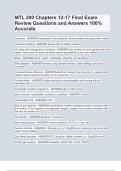Exam (elaborations)
MTL 200 Chapters 12-17 Final Exam Review Questions and Answers 100% Accurate
- Course
- Institution
MTL 200 Chapters 12-17 Final Exam Review Questions and Answers 100% Accurate MTL 200 Chapters 12-17 Final Exam Review Questions and Answers 100% Accurate MTL 200 Chapters 12-17 Final Exam Review Questions and Answers 100% Accurate MTL 200 Chapters 12-17 Final Exam Review Questions and Answ...
[Show more]



